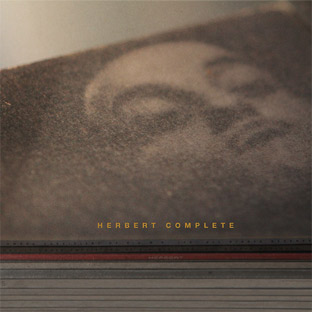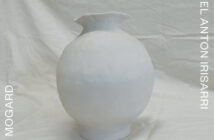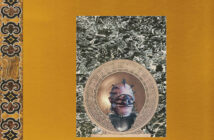To say UK electronic artist Matthew Herbert’s oeuvre is overwhelming is an understatement. It’s overwhelming both in turns of volume and stylistic diversity. A prolific and relentlessly creative artist, he’ remarkably adept at straddling multiple genres, tapping into everything from minimal house, to big band swing to experimental electronics and field recordings. The breadth of his work is even more daunting, when you realise that this collection of 130 tracks only scratches the surface, only taking in works under his house moniker Herbert. None of his music under names like Dr Rockit, Wishmountain, or Radio Boy appear, nor do any of his own remixes for other artists, and there’ none of his Matthew Herbert material, like Score or Plat Du Jour, or his Matthew Herbert Big Band work.
What we do have is Early Herbert, 1996′ 100Ibs, 1998′ Around the House, 2001′ Bodily Functions and 2006′ Scale. As a sweetener he’ included extra material recorded at the time, B-sides and the many remixes he collected for each album.
The 27 tracks on Early Herbert are in the main minimal techno, relentless highly repetitive beats, betraying hints of directions he would later travel, with snippets of jazzy keys or that familiar Herbert house canter. This material is pretty much impossible to find these days, originally released on a series of 12 inches. Unfortunately, despite the interest it provides in terms of his evolution as a composer, this earlier material pales in comparison with the more complex and playful work he would later release. Whilst it lacks certain warmth, it does possess a precociousness and spirit of experimentation that he was able to develop in a more seductive and subtle manner on future releases. Yet there are glimpses of greatness, such as his squelchy Acid Tracks, ostensibly his take on Acid. But this is back when Herbert was following conventions, and playing within structures. Later he developed his own.
There’ a certain austere quality to 100Ibs, it’s quite relentless four on the floor, quite artificial and electronic sounding, music very clearly designed for the dance floor, with clipped vocal samples that kick in just before the bass hits and track titles like Friday They Dance. There are hints of Herbert’s fascination with jazz, yet even this early on his strange blend of jaunty house is truly distinctive, immediately recognisable. Clearly this was a prolific time as he offers another 13 non-album tracks to the collection, and a few such as The Puzzle are pretty wild experimentations with the house form. There’s also another 6 remixes that move from tech house to woozy house and back again from artists like Charles Webster and Motorbass.
1998′ Around The House feels like a real crystallisation of ideas, the BPM’ are much lower and suddenly there’ so much more space. Herbert’s wife and frequent collaborator Dani Siciliano’ appears here and sounds remarkable, particularly on So Now, which is gorgeous and playful with an amazing sensuous and funky bass line that somehow still manages to ooze class. The remainder of the tracks are either voiced by Siciliano or loose playful instrumental house tracks with the odd vocal sample. Some, like the title track are so playful that they wouldn’ be out of place on a Plaid album.
Herbert offers another 10 b-sides and remixes, including his own remix, and whilst they’re not on the same level as the album proper, there is some real experimentation going on with form, such as the hmmmmix of Going Around, in which the main focus is on the repetitive loops of Siciliano’ vocals.
Arguably Herbert’s Bodily Functions was his breakthrough album, the smooth smoky jazzy grooves over skittery electrics topped off by the late night chanteuse of Dani Siciliano. Enough’ been written about it. It’s a classic of the genre, if only we knew exactly what the genre was.
The remixes, a full-length album in themselves, are barely recognisable, bizarre electronic distensions often with little more than the odd gesture or musical phrase to suggest their origin. Herbert clearly told his remixers they should feel free to go to town and infuse their own personality to the tunes. Because he went to town himself, asking no less than 13 people to remix his tunes, saving two of the remixes for himself. By this time too the quality of those stepping up to play with his files had improved, with some pretty heavy hitters, and this collection rivals the original album in its abandence of ideas.
Plaid’s mix of Bodily Functions is hyperactive quirky electrics that you’d expect from the Warp mainstays. Recloose adds little more than a funky as hell electro bass line, whilst David Adju offers up a locked minimal electro groove and previous band member Phil Parnell saunters in and provides a touch of jazz cocktail piano class. Japanese experimentalist Nobakazu Takemura seems to have just pressed fast forward on his cd player before launching some squelching funk assault that is the best remix here. Though without the track listing you’d never know what song it was. Janes Addiction lead singer cum superstar DJ Perry Farrell manages to conjure up a really interesting percussion sound on Addiction, allowing the samples of bottles rattling to play at the beginning of the piece before clipping them up into rigid percussion. DJ Koze constructs a low key smoky atmosphere, with one of the most pleasing Tetris snare sounds you’ll ever hear. He’s also the only artist to manipulate Dani Siciliano’ vocals. Unfortunately he later undoes all the evocative atmosphere he’d so carefully built with a silly electronic squelchy sound meant to be copying Siciliano’ vocal lines. Jamie Liddell, Richard Devine, Matmos, Mr Oizo all offer their take on one of the most iconic albums of the noughties.
Herbert’s Scale was one of his most successful releases, brimming with samples of everyday objects (apparently 613 of them) and recorded in all kinds bizarre places like underwater or in a hot air balloon. It possesses a whimsical kind of old world funkiness with lush Hollywood Bowl style strings that evoke 50′ musicals. If that’s not enough vocalist Dani Siciliano is all over the album.
See the cyclic review here: http://www.cyclicdefrost.com/2006/05/matthew-herbert-scale-k7inertia/
The extras include 6 tracks from the Abbey Road sessions, which are essentially the classical orchestrations with all the electronics and trickery removed. With Siciliano’ vocals, these tunes provide offer a feeling of timelessness, of big band magic, linking Herbert with the era of Nelson Riddle, of Peggy Lee, of Anita O’Day and Frank Sinatra when strings conjured up stardust.
The remixes too are really interesting, such as a purely a cappella version of Harmonise, isolating, and in doing so highlighting the beauty of Dani Siciliano’ vocals. Jamie Liddell creates a hyperactive Moving Like A Train that sounds like electronic cartoon music.
Whew. If you’ve made it this far down, you’ll gather there’ a lot of real quality music in this collection. The extras are albums in themselves and it’s fascinating to hear other artists place their stamp on Herbert’s unique sound. For a Herbert fan this collection is like being the veritable kid in the candy store, you’ll just need to pace yourself however or you’ll have diabetes by the 10th track.




